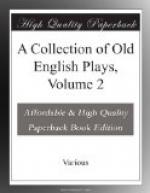[Edricus talks to him.
The next piece (leaves 119-135), which is without a title, is founded on the Charlemagne romances. My friend, Mr. S.L. Lee, editor of Huon of Bordeaux, in answer to my inquiries writes as follows: “Almost all the characters in this play are the traditional heroes of the French Charlemagne romances, and stand in the same relation to one another as in the Lyf of Charles the Grete and the Four Sons of Aymon, both of which were first printed by Caxton, and secured through later editions a wide popularity in England during the XVIth century. I believe, however, that the story of the magic ring is drawn from another source. It is unknown to the Charlemagne romances of France and England, but it appears in several German legends of the Emperor, and is said to be still a living tradition at Aix-la-Chapelle, where the episode is usually localised (cf. Gaston, Paris, Histoire Poetique de Charlemagne, p. 383). Petrarch has given a succinct account of it in a letter written from Cologne, in which he states that he learnt it from the priests of the city, and it is through his narrative that the legend appears to have reached England. John Skelton in his poem ’Why come ye not to court?’ quotes the story, and refers to the Italian poet as his authority (cf. Dyce’s Skelton, II. 48 and 364, where the letter is printed at length). Southey has also made the tradition the subject of a ballad entitled King Charlemain to which he has prefixed a French translation of the passage of Petrarch. In 1589 George Peele in a Farewell addressed to Morris and Drake on setting out with the English forces for Spain tells them to
Bid theatres and proud tragedians,
Bid Mahomet, Scipio, & mighty
Tamburlaine,
King Charlemagne, Tom
Stukeley and the rest
Adieu.
Dyce, in a note on this passage (Dyce’s Peele, II. 88) writes: ’No drama called Charlemagne has come down to us, nor am I acquainted with any old play in which that monarch figures.’ But we know from Henslowe’s diary that in at least two plays that were dramatised from Charlemagne romances the Emperor must have taken a part.” Mr. Lee concludes his most interesting note by suggesting that the present play may be the one to which Peele alludes; but he will at once perceive from my extracts that the date 1589 is much too early. Here is a passage that might have been written by Cyril Tourneur:—
[Ganelon
stabs Richard, his dearest friend,
suspecting
him of treachery.]
Rich. O you’ve
slayne me! tell me, cruell sir,
Why you have doone thys, that
myne innocent soule
May teache repentance to you—
dies.




